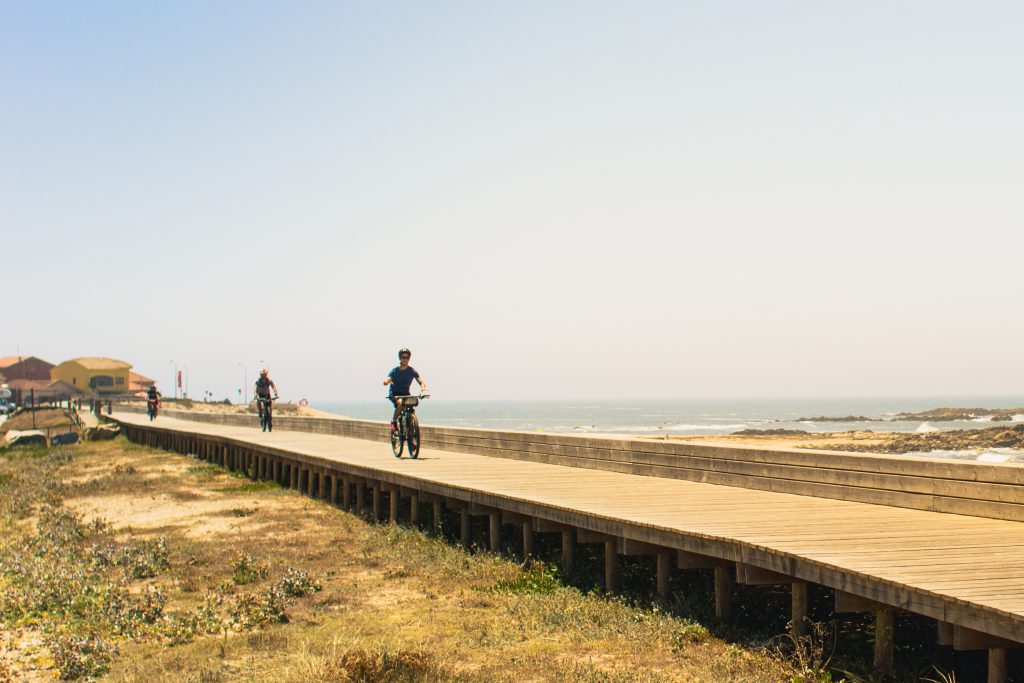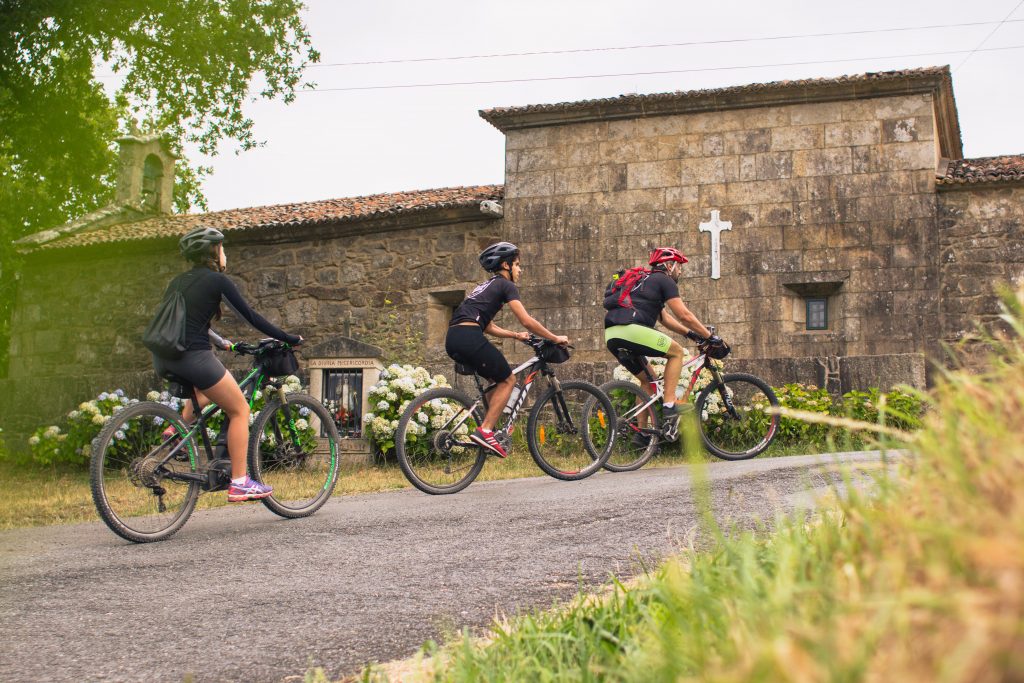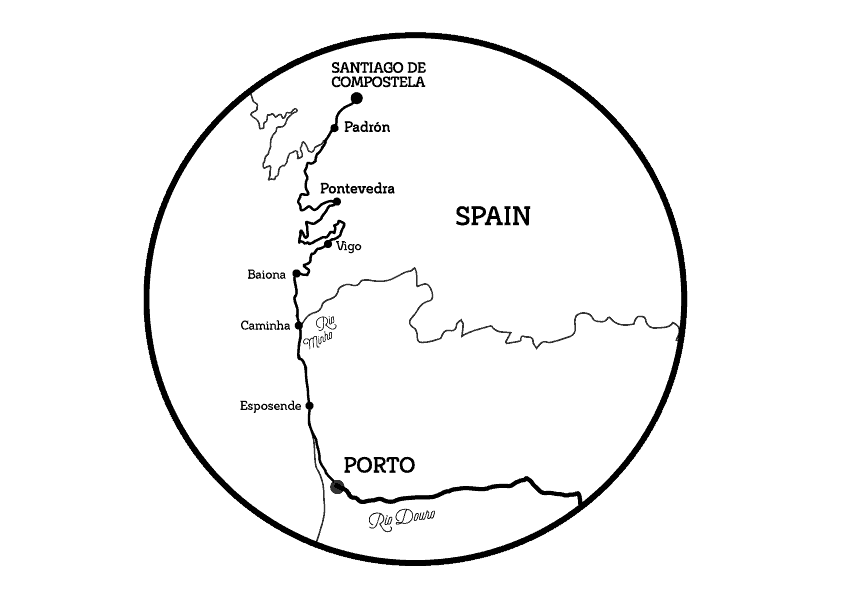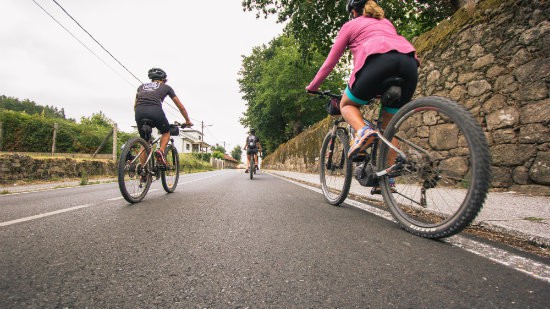If you are planning to ride the Camino de Santiago, you should consider cycling the Portuguese Way, starting from Porto towards Santiago de Compostela. This variation of the way of St. James – one of our most participated Portugal Bike Tours – is growing in popularity, but still offers one of the most authentic ways to experience this pilgrimage, with the added bonus of visiting two countries (starting in Portugal and ending in Spain) and that it takes less time to complete than the original Camino.
In this article, we’ve tapped into our knowledge from operating our bike tour in the Portuguese Way to Santiago to share why, how, when and what to expect on your daily rides as you go from Porto to Santiago de Compostela. Check this guide that showcases the best to make the most of your bike tour in Portugal and Spain.
Cycling the Portuguese Way: a video from our bike tour in the Portuguese Camino
You’ll find a great climate, rich history and culture, world-renowned gastronomy, a true variety of trails and cycling paths as well as beautiful coastal and rural landscapes.
This coastal area is facing the north Atlantic Ocean, and thus has a maritime climate, with an average annual temperature of 16°C and plenty of sunny days throughout the year, making it perfect for cycling. During the winter months of December to March you’ll still find moderate temperatures but also higher rainfall. August is usually the warmest month and temperatures tend to be agreeable to ride only in the morning.
The Way of St. James started out with the legend of the burial of the remains of Saint James, brought over by boat from Jerusalem, in the north of the Iberian Peninsula, in what is now Santiago de Compostela.
The pilgrimage to the Saint’s shrine began as early as the 9th Century and was very popular in Christian Europe throughout the medieval ages as a way to pay homage to Saint James, to earn indulgences and also sometimes as penance for sins committed. Legend also says that in 1325, the Portuguese Queen Isabel made a pilgrimage to Santiago de Compostela, following a route very similar to the one that today is marked with yellow arrows and started a tradition of what is known today as the Portuguese Way of St. James; In this days, besides religious reasons, many pilgrims walk, cycle or horseback ride the Way, for sport, to travel and get to know the regions and also as a way to find some spiritual retreat from our busy and stressful city lives.
Parallel to the significance of the Way of St. James there’s also the rich history of northern Portugal and Galicia, once part of the same kingdom right until the Portuguese independence in the 12th century. The common history of these bordering regions is still visible in the similarities you find today, even after more than 700 years of “separation”.
One of the main things you’ll notice while riding along the Portuguese Way to Santiago are the common traces of the Romanesque architecture in the myriad of churches, manor houses and old bridges you’ll pass and most likely stop to admire or take a photo of.

What is more important after having a tough and exhausting ride during the day than to enjoy a delicious meal paired with great wine? In this aspect, both Portugal and Spain have delicious food, with a variety of fresh fish and seafood, so good to enjoy sitting outside in warm days, paired with the local chilled green wine. Easy to find is the hearty comfort food that you’ll be able to enjoy near the fireplace, with a glass of full-bodied red wine from the neighbouring regions of the Douro and La Rioja.
Being bathed by the Atlantic ocean means both countries thrive on fantastic, fresh fish and seafood, expertly used in their trademark Mediterranean cuisine. But both countries have great variety of cultures, climate variation and landscapes, which means each region has also an endless variety of nourishing stews, grilled and oven-baked meats, cheese, wines and local specialities. From Michelin star restaurants to regional “tascas” and “tapas” places, you’ll find yourself in a foodie’s heaven.
One of the enchants of riding the Way’s Coastal Path is of course to experience the first days of coastal views and flat bike paths by the beach, that will take you along the northern coast of the peninsula, riding through seaside towns facing the ocean. The scenery will change after the 3rd day and you’ll be amazed by the ease with which you’ll be able to immerse in bucolic rural and forest landscape that you’ll find at such a short distance from the coast. Riding the Portuguese Way means you’ll be able to rest in, visit and explore, exciting ancient cities with beautiful architecture from all eras that will make your travel so worthwhile. Deserving a special mention are places like the starting city of Porto, a sparkling jewel sprawling to the hills of the north bank of the Douro River, going all the way to the river mouth, and with its traditional buildings of dark granite stone, facades of bright colours, topped with red tile roofs. Already in Spain you won’t forget your visit to the cities of Pontevedra with the charming pedestrian centre area, where you’ll enjoy walking the medieval streets and buildings that surround the magnificent cathedral, a focal point for the pilgrims of the Way, but definitely not the only one, as you’ll find out by yourself, passing by the myriad of great restaurants with outside sitting areas that will enable you to live this city like the locals like to. Santiago de Compostela as your final destination is in itself a spectacular place to walk around and visit. The magnificent Cathedral dominates the central square and the medieval streets spread all the way to the old city walls.
You’ll be amazed at the variety of roads, paths and trails that you’ll ride on your way to Santiago de Compostela. Every day you’ll find yourself riding in such diverse roads that you’ll never get bored. This means that you’ll have to be attentive and aware of these ever changing conditions but also means that your riding experience will be so enriched by it. One of the great allures of riding the Way is the marked path along your ride, the yellow arrows and scallop shells are ubiquitous and will make it very difficult for you to get lost. And if by any chance you actually do, then you’ll always find someone along the way to guide you back. There is a special feeling of camaraderie amongst all the pilgrims, whether they are walking, riding a bike or on horseback. The same happens with almost all people form the towns and villages along the route, so used to receive, exchange experiences and stories with the pilgrims.

We suggest riding from April to late October. Spring and late summer/autumn are the perfect seasons, while the summer time will always be tempered by winds from the North. Even early November can be considered, especially during the summer of St.- Martin.
This ride is suggested for intermediate riders, and the best bike for the job is a mountain or hybrid bike. While most of the Way is not technical, there are occasional spots where a mountain bike will be of help, especially when crossing the few remains of roman pathways along the way. But for most of the ride, a touring tire will do, so we suggest a standard hardtail or full-suspension mountain bike build with touring tires. The terrain is sized but will mostly be composed of backroads, macadam trails, etc. Gravel can work as well, but a few sections will be hard on the arms if you choose this type of bike. If you opt for an E-buke, we suggest an E-mountain bike, for the reasons listed above.
We suggest 5 to 7 riding days. Experienced riders can certainly take less time ( 3 days maybe), but that’ll reduce the immersion feeling of the pilgrimage and will certainly leave you less time to explore the quaint villages or meeting other pilgrims along the way.
For some riders, the St. James Path is a religious experience, but we dare to say that it is a spiritual experience for all of them. Cycling the Portuguese Way to Santiago de Compostela, whether from France, Spain or Portugal is a milestone for many riders, as the Camino leaves its mark in you. The Portuguese Camino is best ridden from Porto (or Lisbon, if you have 15 days total to ride), and you’ll get to ride by the northwest of Portugal – the Minho region – and Galicia, in Spain, until you reach Santiago de Compostela. The two best paths from Porto are the Coastal Path and the Central path, both of which ride north – one by the coastline, the other roughly 30km inland, until they merge in Pontevedra, Spain, staying as one all the way to Santiago.
Both Caminos are signalled out by yellow arrows or scallop shells, pointing towards Santiago de Compostela cathedral, making it easy to follow, although if you follow the arrows precisely, you might have to cross some occasional trails and roads which are quite difficult to tackle. What differentiates the Portuguese path from the more known French or Spanish ones is its authenticity – the Camino is not as smooth as the others might be; on the contrary, it’s more raw, authentic and adventurous. The central path will provide you with more historical and cultural depth in the Minho region, as you ride by the beautiful Romanic cities of Barcelos, Ponte de Lima and Valença, and is a bit tougher to climb, especially after Ponte de Lima, in the “Labruja” Sierra. The coastal path is smoother and less demanding on the first days but, if you follow all the yellow arrows, you’ll find some technical terrain in the second and third days that might slow your progress. Both paths have varied terrain – beautiful tarmac, macadam trails, ancient Roman roads, some trails – and are mostly done by forests and rural areas, with occasional more dense urban areas like Porto, Vigo and Pontevedra. The best bike option for the Camino is a mountain or touring bike, because of the mixed terrain – you can do it by road but you won’t be able to follow all the indications. Intermediate to Expert riders might take 4 to 5 days to ride the Camino from Porto, while beginners/intermediate riders might take 6 to 7 days – everybody can do the Camino, but we advise some preparation, as beginners might need to spend many hours on a bike every day.

Our suggested day to day experience to cycling the Portuguese Way along the coastal path ( and the one we use on our bike tours) is as follows:
You should arrive a few days early or at least a day early so that you have the time to visit the beautiful and cosy city of Porto, rich with history and monuments like the Clérigos Tower and the D. Luis Bridge. The old quarters of Baixa with its local shops, restaurants and pastry shops, Ribeira a quarter by the river Douro, facing the wine cellars of the Port wine, full with the city’s traditions and historical connection to the wine and the wine country of the Douro. Shopping areas such as Santa Catarina and Aliados Avenue. Not to miss are the great restaurants around town with some of the tastiest food in the country.
On your first riding day we suggest you collect your pilgrim passport and start your adventure by riding from the Porto Cathedral. There you’ll also find the most magnificent views over the city of Porto, its bridges and the Douro River. The ride starts by descending through the old streets and buildings of Sé Velha and Mouzinho da Silveira street, to arrive at Porto’s riverside Ribeira, where here you’ll enter the cycle paths alongside the Douro river, that will take you all the way to Leça da Palmeira. From here on, you’ll start following the yellow arrow’s by Portugal’s coastline, towards the north. The Camino will be a mix of cycle paths, paved roads and walkways all the way until you reach the historical city of Vila do Conde and the beach resort plus fishing town of Póvoa do Varzim – both of which are great options to stop at, and maybe eat their famed fresh fish and seafood. After Póvoa do Varzim, you’ll pass several smaller fishing villages until you reach Fão, the place where the route will turn towards the ocean once more and take you along the Pinetree forested area of Ofir, a seaside village where we suggest you stay.
From Ofir you’ll head north, crossing the river to Esposende and then a bit inland following alongside the Cávado River passing through a couple of quaint villages. At km15 you’ll start climbing and enter a more technical trail that will lead you to you a very narrow bridge across the Neiva river – another climb will follow until you reach Viana do Castelo. In this seaside city go across the river, and admire the Santa Luzia church that sits on top of the nearby mountain range. The historical city centre is a great option to stop for lunch and really worth a visit. After Viana, you’ll keep riding north and inland, through the mountain range where some urban single tracks and ancient paved roads will lead you all the way to the beachside town of Vila Praia de Âncora. Here you’ll enter the Ecopista or cycling path, along the shoreline that will take you to the cosy riverside village of Caminha, on the southern bank of the Minho River that marks the border between Portugal and Spain.
After your last night in Portugal head riverside and board the ferry boat to take you A Pasaxe (there’s one every hour, except on Monday), and thus entering Spain. This day offers no big climbs, just ups and downs along the coast of Galicia, through small seaside villages like Oia and Pedra Rubia until you reach Baiona, a beautiful coastal town. Along the way, take time to enjoy these medieval villages across the Galician coastline, and taste the wonderful tapas and seafood. Today you’ll experience a short but sweet ride, to prepare you for your next day, which is the toughest ride of the week, so take your time to relax in Baiona!
Today might just be the toughest day of your Camino so we suggest you to have a good breakfast and then resume your ride along the coast and the Sound region towards Vigo town, that’s 25km away from Baiona. One of the highlights of the day is the short but steep climb to reach Saigráns that will enable you to experience one of the most beautiful views of the region: Vigo’s Sound, where the seawater mixes with the Verdugo River, and you’ll be able to see the “bateas” where mussels are produced (a local delicacy) and the Ciés islands in the background – a natural park in the middle of the Atlantic Ocean. You will then descend into the busy city of Vigo and then back up, towards the mountain range that overlooks the Ria de Vigo – 12km of macadam trails overlooking the Ria, followed by a descent towards Redondela – from Redondela, the central path and the coastal path merge to become one! Another climb near Cessantes and then a descent to cross the Verdugo river over the Romanic bridge of “Ponte Sampaio”. One final push after and then, from km28 on, it’s a long descent until you reach Pontevedra and its beautiful historical centre. Take your time to explore Pontevedra’s centre on a walk at night time by the Galician plazas of Ourense and Ferraria, where you’ll find the city’s Basilica and Chapel.
On this day you’ll continue your pilgrimage, feeling that you’re already getting close to Santiago. You’ll notice a change in the landscape as you’ll be abandoning the coast and returning to inland Galicia, with its lush green woods and forested areas. Start your ride by crossing Rio Lérez and riding north, on the trails alongside the train tracks, facing a climb just under 3km long and with an average inclination of 3,5% – including a couple of steep and technical short sections. Once you cross the river Barosa, you’ll encounter the National Road N550 – pay attention to the crossings in this road. You’ll then keep moving alongside this national road until you reach Caldas de Reis, renowned as a thermal resort. From here, the next 7 kms are upwards. First, a gentle climb out of Caldas de Reis which then gets steeper towards its end. You’ll be riding by trails and backroads, close to the N550 or the highway, taking you through the farmlands and woods of the Camino. As you get closer to the town of Pontecesures, just before Padrón, you’ll see more buildings and share the road with a few cars. Cross the bridge over Rio Ulla and reach Padrón, a village known for being the cradle of Galicia and for its Green Peppers, the Padrón Peppers. Take some time to visit the village, climb to the Santiaguiño do Monte lookout point, visit the botanical gardens or Toxa waterfall and taste the food. If you’re adventurous and it’s in season try the lamprey.
This will be your last riding day on the Way of St. James. The distance is short but it will be a small test to your will and tenacity as the route starts going gently uphill almost from the start and will be so till you get to Santiago. As you exit Padrón you’ll enter a series of rural trails between villages and churches near small forested areas, with plenty of small steep climbs, as well as clear signs that the end of the Way is near. As you get closer to Santiago de Compostela you’ll start to have glimpses of the urban area surrounding it. When you arrive visit the plaza surrounding the Santiago de Compostela Cathedral, and if inclined to do so, enter it and attend the pilgrim’s mass. If you have time go to the pilgrims’ office and collect your pilgrim certificate with your fully stamped pilgrim passport. Indulge in a great meal in some of the great restaurants around town, serving great market vegetables and produce, fish and seafood, as well as hearty meat dishes.
Santiago Compostela is an ancient city that really deserves a more prolonged visit and instead of leaving right after your arrival, we suggest you stay at least an extra day to admire and visit the beautiful monuments and places, such as its plazas in the central area of the old town and the narrow streets and traditional markets within the old city walls. If you haven’t done so on your arrival day, dedicate this day to visit the pilgrims’ office and discover this medieval city’s traditions, culture and heritage.

Want more info on this bike tour?
Visit our website, Live Love Ride – Portugal Bike tours or make sure to contact us at ridewithus(@)liveloveride.pt – we’d love to hear from you! Or click to view our other guides on our blog ? Cycling Portugal.
If you book one of our multi-day bike tours in Portugal and enjoy an additional free night in Lisbon or Porto, at the beginning or end of your tour – and, if you are booking for 2021, you can also benefit from an early bird discount of 5% on all our multi-day tours, just by booking ahead*.
How can you benefit from this offer? Simply choose one of our signature multi-day Bike Tours running in Continental Portugal, whether as a private self-guided/guided or scheduled group tour option, and choose in which city you’d like to spend the extra night in, right at the start or end of the tour*!
We’ll be waiting for you to enjoy a “Clean and Safe” experience in Portugal – the first night is on us! Click here for all information regarding this promotion!